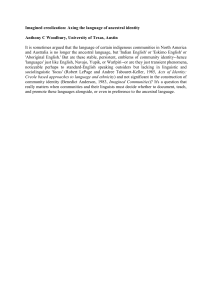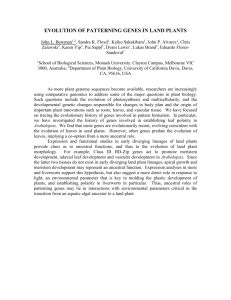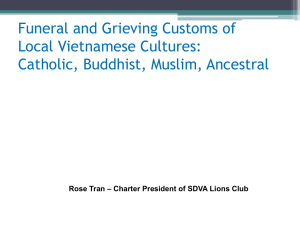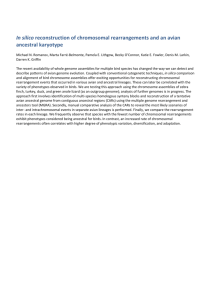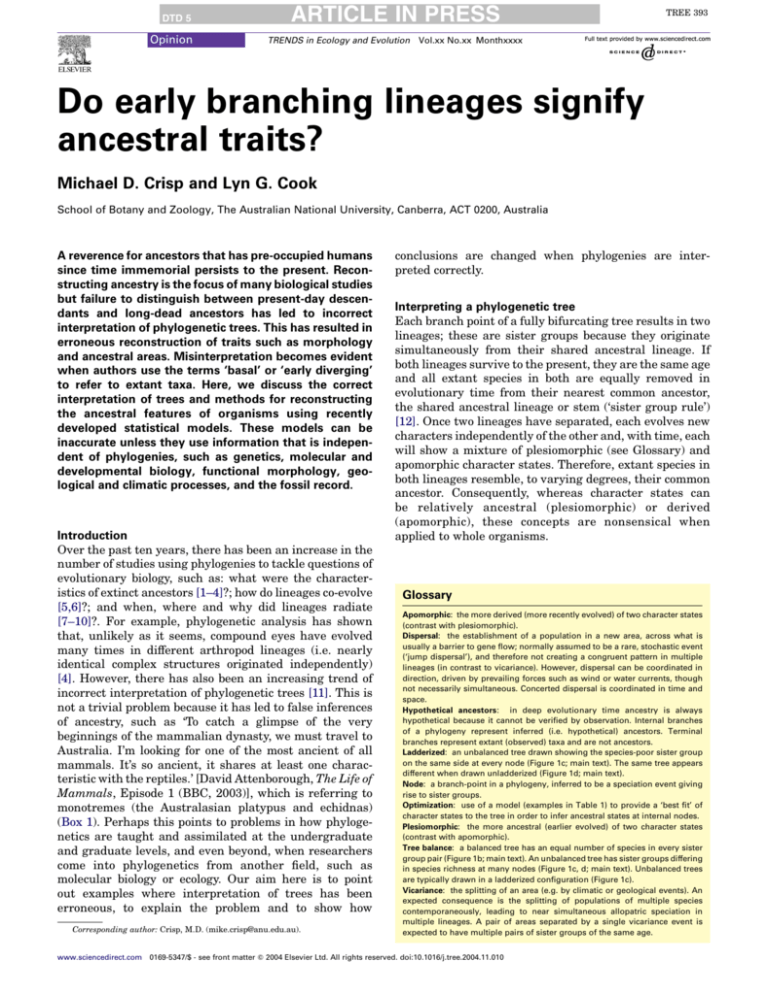
DTD 5
Opinion
ARTICLE IN PRESS
TRENDS in Ecology and Evolution
TREE 393
Vol.xx No.xx Monthxxxx
Do early branching lineages signify
ancestral traits?
Michael D. Crisp and Lyn G. Cook
School of Botany and Zoology, The Australian National University, Canberra, ACT 0200, Australia
A reverence for ancestors that has pre-occupied humans
since time immemorial persists to the present. Reconstructing ancestry is the focus of many biological studies
but failure to distinguish between present-day descendants and long-dead ancestors has led to incorrect
interpretation of phylogenetic trees. This has resulted in
erroneous reconstruction of traits such as morphology
and ancestral areas. Misinterpretation becomes evident
when authors use the terms ‘basal’ or ‘early diverging’
to refer to extant taxa. Here, we discuss the correct
interpretation of trees and methods for reconstructing
the ancestral features of organisms using recently
developed statistical models. These models can be
inaccurate unless they use information that is independent of phylogenies, such as genetics, molecular and
developmental biology, functional morphology, geological and climatic processes, and the fossil record.
Introduction
Over the past ten years, there has been an increase in the
number of studies using phylogenies to tackle questions of
evolutionary biology, such as: what were the characteristics of extinct ancestors [1–4]?; how do lineages co-evolve
[5,6]?; and when, where and why did lineages radiate
[7–10]?. For example, phylogenetic analysis has shown
that, unlikely as it seems, compound eyes have evolved
many times in different arthropod lineages (i.e. nearly
identical complex structures originated independently)
[4]. However, there has also been an increasing trend of
incorrect interpretation of phylogenetic trees [11]. This is
not a trivial problem because it has led to false inferences
of ancestry, such as ‘To catch a glimpse of the very
beginnings of the mammalian dynasty, we must travel to
Australia. I’m looking for one of the most ancient of all
mammals. It’s so ancient, it shares at least one characteristic with the reptiles.’ [David Attenborough, The Life of
Mammals, Episode 1 (BBC, 2003)], which is referring to
monotremes (the Australasian platypus and echidnas)
(Box 1). Perhaps this points to problems in how phylogenetics are taught and assimilated at the undergraduate
and graduate levels, and even beyond, when researchers
come into phylogenetics from another field, such as
molecular biology or ecology. Our aim here is to point
out examples where interpretation of trees has been
erroneous, to explain the problem and to show how
Corresponding author: Crisp, M.D. (mike.crisp@anu.edu.au).
conclusions are changed when phylogenies are interpreted correctly.
Interpreting a phylogenetic tree
Each branch point of a fully bifurcating tree results in two
lineages; these are sister groups because they originate
simultaneously from their shared ancestral lineage. If
both lineages survive to the present, they are the same age
and all extant species in both are equally removed in
evolutionary time from their nearest common ancestor,
the shared ancestral lineage or stem (‘sister group rule’)
[12]. Once two lineages have separated, each evolves new
characters independently of the other and, with time, each
will show a mixture of plesiomorphic (see Glossary) and
apomorphic character states. Therefore, extant species in
both lineages resemble, to varying degrees, their common
ancestor. Consequently, whereas character states can
be relatively ancestral (plesiomorphic) or derived
(apomorphic), these concepts are nonsensical when
applied to whole organisms.
Glossary
Apomorphic: the more derived (more recently evolved) of two character states
(contrast with plesiomorphic).
Dispersal: the establishment of a population in a new area, across what is
usually a barrier to gene flow; normally assumed to be a rare, stochastic event
(‘jump dispersal’), and therefore not creating a congruent pattern in multiple
lineages (in contrast to vicariance). However, dispersal can be coordinated in
direction, driven by prevailing forces such as wind or water currents, though
not necessarily simultaneous. Concerted dispersal is coordinated in time and
space.
Hypothetical ancestors: in deep evolutionary time ancestry is always
hypothetical because it cannot be verified by observation. Internal branches
of a phylogeny represent inferred (i.e. hypothetical) ancestors. Terminal
branches represent extant (observed) taxa and are not ancestors.
Ladderized: an unbalanced tree drawn showing the species-poor sister group
on the same side at every node (Figure 1c; main text). The same tree appears
different when drawn unladderized (Figure 1d; main text).
Node: a branch-point in a phylogeny, inferred to be a speciation event giving
rise to sister groups.
Optimization: use of a model (examples in Table 1) to provide a ‘best fit’ of
character states to the tree in order to infer ancestral states at internal nodes.
Plesiomorphic: the more ancestral (earlier evolved) of two character states
(contrast with apomorphic).
Tree balance: a balanced tree has an equal number of species in every sister
group pair (Figure 1b; main text). An unbalanced tree has sister groups differing
in species richness at many nodes (Figure 1c, d; main text). Unbalanced trees
are typically drawn in a ladderized configuration (Figure 1c).
Vicariance: the splitting of an area (e.g. by climatic or geological events). An
expected consequence is the splitting of populations of multiple species
contemporaneously, leading to near simultaneous allopatric speciation in
multiple lineages. A pair of areas separated by a single vicariance event is
expected to have multiple pairs of sister groups of the same age.
www.sciencedirect.com 0169-5347/$ - see front matter Q 2004 Elsevier Ltd. All rights reserved. doi:10.1016/j.tree.2004.11.010
ARTICLE IN PRESS
DTD 5
Opinion
2
TRENDS in Ecology and Evolution
Box 1. The monotreme example explained
The ‘discovery’ of the platypus by Europeans 200 years ago
provoked outrage over what was thought to be a hoax and
monotremes have remained an enigma ever since. The orthodox
view is that monotremes are survivors of ancient Mesozoic
ancestors and are not closely related to other mammals [30].
Moreover, they have been considered to be a living museum of
ancestral ‘reptilian’ features, such as egg laying. With only three
living species, they are a classic example of naı̈ve misinterpretation
of evolutionary history. However, recent studies of monotremes
have overturned both fallacies.
Molecular phylogenetics has shown that the three major lineages
of living mammals (monotremes, marsupials and placentals)
diverged so closely in time (no more than 20 million years apart,
probably between 180 and 140 million years ago) that it has been
difficult to determine which two are more closely related [30,31]. The
relationship is so close that some analyses (e.g. with the use of
mitochondrial genes [32]) support the ‘Marsupionta’ hypothesis, in
which monotremes and marsupials are sister groups, with placentals more distantly related. However, these results were probably
influenced by uncorrected biases in the data. Analyses that corrected
these biases retrieved the conventional ‘Therian’ phylogeny, which
groups placentals with marsupials, with monotremes being sister to
these [31].
If a mammalian phylogeny had been constructed early in the
Cretaceous, at a time when the monotremes were relatively diverse
[30], the naı̈ve perception of the phylogeny might have been
reversed, with the therians appearing ‘basal’ (cf. Figure 1e–g main
text). Discussion of the evolution of features might then have
focussed on the reptilian features of placentals and the advanced
features of monotremes. The reality is that mammals are a
monophyletic group and, therefore, are all equidistant from their
common ancestor. All mammals, including monotremes, are a
‘patchwork of reptile, mammal and unique features’ [33]. Monotremes share at least six uniquely derived morphological, chromosomal and developmental features and, for each of these, their sister
group, the therians, have the plesiomorphic state found in the
common mammalian ancestor [30,31,33]. For example, monotremes
have nine or ten sex chromosomes that form complex chains at
meiosis [34]. This feature is otherwise unknown in vertebrates.
(a)
TREE 393
Vol.xx No.xx Monthxxxx
An internal node of a tree can be referred to as being
‘basal’ or ‘derived’ in relation to another node, because
internal nodes are hypothetical ancestors. A node is ‘basal’
if it is closer to the root than to the ‘derived’ node along any
given path through the tree between the root and a
terminal branch (Figure 1a).
A common misinterpretation of trees
Commonly, one lineage of a sister group pair has fewer
extant taxa than does the other and we refer to such cases
as the species-poor sister group and the species-rich sister
group, respectively. A misinterpretation of trees occurs
when the species-poor sister group is thought of as ‘basal’
or ‘early diverging’ with respect to its species-rich sister.
Conversely, the species-rich sister group is misconceived
as ‘derived’ or ‘advanced’ with respect to its species-poor
sister. Both interpretations are flawed because the sister
groups diverge simultaneously from their nearest common
ancestor.
This misreading of phylogenies is encouraged by
asymmetrical trees (tree balance) [13], because it could
appear that one or more lineages are diverging from a
main stem. The illusion can be even greater in unbalanced
trees (also called ‘pectinate’ or ‘Hennigian comb’ trees),
especially if the trees are ladderized [14] and misread as
though there were a phylogenetic progression in the
terminal (extant) taxa, across the top of the tree. However,
there are two sister groups across every node in a fully
bifurcating tree and, therefore, each node results in two
lineages diverging from each other. This applies regardless of whether the tree is balanced (Figure 1b) or not
(Figures 1c,d), and whether it is drawn as ladderized
(Figure 1c) or not (Figure 1d). Therefore, the misinterpretation results from reading trees in a one-sided way.
(b)
Derived
Derived
Neither basal
nor derived
t2
Reference node
Basal
t1
(c)
(d)
A
B
C
D
E
F
B
D
E
F
C
A
t0
(e)
(f)
(g)
TRENDS in Ecology & Evolution
Figure 1. Interpretation of trees in relation to their shape. (a) Correct use of ‘basal’ or ‘derived’ when referring to a tree. Internal nodes of a tree can be referred to as ‘basal’ or
‘derived’, but only with respect to another node (the ‘reference node’) that is situated along the same path from the root to a terminal of the tree. A node situated on a different
root-terminal path is neither basal nor derived with respect to the reference node. (b–d) Tree balance. (b) Balanced tree: there is the same number of species on either side of
every node. (c) and (d) Unbalanced tree: there are unequal numbers of species on either side of each node. (c) Tree drawn as ladderized by showing the species-poor sister
group on the left at every node. This presentation is prone to the naı̈ve interpretation that there is a phylogenetic progression from left (‘basal’ taxa) to right (‘derived’ taxa).
(d) The same unbalanced tree redrawn by swapping sister groups at alternate nodes. This presentation could be less prone to misinterpretation than the ladderized version.
(e–g) Hypothetical evolutionary tree showing that tree balance can switch between lineages through time in two sister groups (red and blue). (e) Both sister groups originate
at the speciation event at time t0 and therefore are the same age. All lineages arising within both taxa are shown until the present (t2). Thin lines indicate lineages that go
extinct. (f,g) Phylogeny of the two sister groups at t1 and t2 respectively (omitting extinct lineages) showing reversal of tree balance.
www.sciencedirect.com
DTD 5
Opinion
ARTICLE IN PRESS
TRENDS in Ecology and Evolution
TREE 393
Vol.xx No.xx Monthxxxx
3
Box 2. ‘Basal’ angiosperms
Relationships at the base of the angiosperms (flowering plants)
have received much attention over a long period of time (reviewed
in [35,36]), driven by a quest to reconstruct the morphology and
biology of the common angiosperm ancestor (e.g. [2,37–39]).
Difficulty in achieving this, classically referred to as ‘Darwin’s
abominable mystery’, still persists. Reconstruction of ancestral
traits of angiosperms has been problematic because of poor
phylogenetic resolution at deeper levels, a lack of unequivocal
transitional forms in the fossil record, obscure homologies
between angiosperms and other seed plants, and the great
diversity of traits among extant angiosperms [35]. Some studies
have inferred ancestral states objectively by mapping and
optimizing characters across whole trees [37,38,40,41]. However,
many authors have misinterpreted a species-poor sister group as
being ‘ancestral’ and, as phylogenies have changed (Figure I), so
too has the misinterpretation. Groups that were thought successively to be ‘basal’ are the magnoliids, especially Magnoliaceae
(up to 1980), Chloranthaceae (1980s), Ceratophyllum (1993)
(Figure Ia), and the ANITA grade (Amborella, Nymphaeales,
Illiciales, Trimeniaceae and Austrobaileya) (from 1999) (Figure Ib)
[2]. For example:
† Calycanthales were hypothesized to be the ‘archetype’ of the
angiosperms [42].
† Support for Ceratophyllum as the sister group was inferred from
‘primitive’ features identified in the flowers of these plants [43].
† The ‘ancestral’ DNA content was first inferred from Ceratophyllum
[44] and later from the ANITA grade [45].
† Amborella was stated to represent the first stage of angiosperm
evolution [46].
† Amborella, inferred as the ‘most ancient angiosperm’, was
examined for chloroplast genes characteristic of gymnosperms
(a more distant sister group) [47].
† When rice (Oryza, representing the grasses) was placed as the
sister group, it was inferred to have greater affinity to Pinus than to
other angiosperms [43].
These inferences are equivalent to considering monotremes ‘reptilian’
because of shared egg-laying (Box 1).
Ironically, many of the features identified as being ‘basal’ in sister
groups are likely to be independently derived and highly specialized,
such as the morphological and physiological adaptations in Ceratophyllum and Nymphaeales to their aquatic habitat [38,43], absence of
vessels in the wood of Winteraceae [37,48] and floral development in
Amborella [49].
Some studies have used an appropriate sampling strategy for their
purpose, albeit by targeting ‘basal’ angiosperms (e.g. [38,40,41,50]).
This can be suitable if multiple sister groups are sampled across both
sides of the deeper nodes of a phylogeny, rather than focussing on the
species-poor sister group alone. Two-sided comparisons are more
likely to sample the maximum phylogenetic diversity in traits.
(a)
Asteridae
Rosidae
Caryophyllids
Gunneraceae
Hamamelids
Ranunculids
Paleoherbs II
Magnoliales
Laurales
Monocots
Paleoherbs I
Ceratophyllum
Gnetophytes
Conifers
Amborella
(b)
Nymphaeales
Illiciales
Trimeniaceae
Austrobaileyaceae
Monocots
Laurales
Magnoliales
Piperales
Winterales
Eudicots
(c)
Lotus
Arabidopsis
Oenothera
Nicotiana
Spinacia
Calycanthus
Nymphaea
Amborella
Zea
Triticum
Oryza
Pinus
Psilotum
Marchantia
Figure I. Changing sister group reconstructions in angiosperms through time.
(a) Ceratophyllum, (b) Amborella and (c) Grasses. Reproduced, with permission, from [46,51,52], respectively.
One-sided reading of trees can also cause paradoxes.
Two sister groups can alternate in appearing ‘basal’ if the
timing of speciation and extinction events differs between
the two lineages. For example, in Figure 1e–g, two sister
groups undergo the same number of speciation events
following divergence from their common ancestor. The
major difference between the groups is that one group
radiates later (seven speciation events after t1) than does the
second group (five speciation events before t1) (Figure 1e). If
a phylogeny is constructed showing relationships among
taxa extant at t1, the species-poor group (one species) could
www.sciencedirect.com
be misinterpreted as being ‘basal’ relative to the species-rich
group (five species) (Figure 1f). However, at t2, this
misinterpretation would be reversed, with the species-poor
group (two species; previously the species-rich group)
appearing ‘basal’ relative to the species-rich group
(six species; previously the species-poor group) (Figure 1g).
This reversal is paradoxical only in terms of a false
assumption that one extant sister is older than the other.
The misinterpretation of one sister as being ‘basal’ and,
therefore, having more ancestral traits compared with the
‘derived’ sister, can result in an unjustified reconstruction
DTD 5
Opinion
4
ARTICLE IN PRESS
TRENDS in Ecology and Evolution
TREE 393
Vol.xx No.xx Monthxxxx
Box 3. An example of ancestral area reconstruction by misinterpretation
In a study of African violets, Saintpaulia spp. [53], an ancestral area
was inferred by misinterpretation, although no unambiguous reconstruction is possible from the tree. The African violets are essentially
restricted to three isolated mountain ranges, with each range having
different endemic violet species. In a molecular phylogeny, each of the
three main lineages corresponds to one mountain range (Figure Ia)
and the single species in the Uluguru Mts is sister group to the rest.
Based on this information alone, Uluguru was inferred as the ancestral
area of Saintpaulia and the source of dispersal and evolution of the
other lineages into the other two mountain ranges (Figure Ib).
However, several reconstructions are equally likely, as costed by the
total number of events (speciation, dispersal and vicariance).
Figures Ib–d illustrate three of six equally probable dispersal
reconstructions (all require two dispersals with subsequent speciation). A vicariance explanation (not shown) has the same cost. First,
area A splits away from united area BCC, then B and C split into
separate areas (two vicariance events with subsequent speciation).
Another equally costly scenario (not shown) would be a dispersal from
A to BCC, followed by a vicariance between B and C.
Therefore, independent information, such as factors affecting the
dispersal of the plants, should be used in conjunction with the tree.
Also, dated fossils or known age of mountain ranges (if young relative
to the speciation events) could be used with molecular modelling to
test hypotheses. For example, if the speciation event separating
S. goetzeana from the rest of Saintpaulia was found to be older than
the Uluguru Mts, this range could be ruled out as the ancestral area.
Streptocarpus saxorum
(a)
Streptocarpus caulescens
A
Saintpaulia goetzeana
B
C
(b)
Saintpaulia teitensis
Saintpaulia
‘ionantha’
complex
A
B
C
(c)
A
B
Figure I. Alternative biogeographical reconstructions of Saintpaulia.
(a) A phylogeny of African violets Saintpaulia spp. indicating the areas in which
they occur (A, Uluguru Mts, B, Teita Hills, C, Usambara Mts). A naı̈ve (‘basal’)
interpretation of this tree would consider the species-poor sister group (blue) to
be ancestral and, thus, its area (A), as the centre of origin for the entire lineage.
Likewise, taxa in the species-poor area B (red) would be considered to be
ancestral to the taxa in area C (violet). (b) The same tree simplified and showing
the naı̈ve reconstruction of origin and dispersal. (c) The same tree results if
area B is ancestral, with independent dispersals from this source to areas A and C.
(d) A third reconstruction, in which area C is ancestral. (a) Reproduced, with
permission, from [53].
of ancestral traits that otherwise might have been
ambiguous if valid character-state reconstruction
methods had been used; that is, traits found exclusively
in the species-poor sister group are mistakenly assumed to
be ‘primitive’ and to represent traits of the common
ancestor of both sisters. This is the fallacy underlying the
quote above about monotremes and is explained in Box 1.
However, the intuition that character states occurring in
multiple lineages are likely to be ancestral does have some
validity (Box 2).
Examples of misinterpretation of trees
Reconstructing the ancestral angiosperm is a popular area
of research and the literature is replete with simplistic
misinterpretation of phylogenies. Progress in phylogenetic methods and new sources of data have resulted in
different species-poor groups being hypothesized successively as being the sister group to the rest of the
angiosperms. With misinterpretation, each of these sister
groups has been successively assumed to represent the
ancestral angiosperm and research programs have been
repeatedly refocused to investigate the assumed ancestral
www.sciencedirect.com
C
(d)
A
B
C
features of each (Box 2). Thus, misinterpretation of trees
can mislead the setting of research objectives.
Simplistic interpretation of phylogenies is common in
biogeography, a complex field that involves questions and
methods that are too diverse to be reviewed here (but see
[15]). For example, one approach attempts to reconstruct
the history of continental break-up by comparisons of
phylogenies of multiple taxa [9]. Another approach
attempts to trace the history of a single lineage back in
time and space to its ancestral area [16]. Several authors
have naı̈vely assumed that a species-poor sister group
occurs in the ancestral area (Hennig’s Progression Rule
[17]). Such an inference can give a false sense of
decisiveness in the data, even though no solution is
possible from knowing the tree and distribution of
terminal taxa alone (Box 3).
How to use phylogenies to reconstruct ancestral states
The reconstruction of ancestral states presents numerous
challenges because of the inherent limitations of the
available data (e.g. [14,18–20]). However, in spite of
extensive reviews [19–21] and empirical comparisons of
ARTICLE IN PRESS
DTD 5
Opinion
TRENDS in Ecology and Evolution
TREE 393
Vol.xx No.xx Monthxxxx
5
Table 1. Methods and models for inferring ancestral areas
Method or model
Type
Properties
Deficiencies
Parsimony
Pa
Minimizes discrete-state
changes over the tree; state
changes can be weighted
equally (Fitch) or differentially using step matrices
Cannot indicate probability
of estimates; does not use
branch lengths, thus
underestimates change
when it is frequent relative
to speciation
Dispersal vicariance
analysis (DIVA)
P
Uses cost matrices to
estimate ancestral areas;
differentially costs
vicariance and dispersal
Bias towards sympatric
speciation and against
early dispersal
Markov continuous time
transition model
MLb
Estimates rate of discretestate changes, allowing
asymmetry
Punctuated evolution
model
ML
Assumes evolutionary
change occurs only at
speciation
Evolutionary assumptions,
e.g. that rate of change is
constant throughout the
tree, can be unrealistic (see
punctuated models)
Evolutionary assumption is
equivalent to having equal
branch lengths and likely to
be unrealistic, as in parsimony
Generalized least squares
(ZSquared change
‘parsimony’)
ML
Minimizes sum of squared
changes over the tree;
Brownian motion model of
evolution; uses branch
lengths
Maximum likelihood with
General time reversible
model
ML
Stochastic (Bayesian
inference), e.g. using
Markov continuous time
transition model
Bd
Based on Markov model,
adapted from nucleotide
modelling; allows differential rates and symmetry
Models multiple parameters including tree
topology; posterior probabilities given for estimates
Does not indicate probability of estimates; nondirectional version cannot
reconstruct ancestral
values outside range of
descendant values
Can fail if model unrealistic
Can fail if model unrealistic
Examples of appropriate
use
Double fertilization, long
thought to be a unique
defining character of
angiosperms, might have
originated independently
in gymnosperms, or earlier, in the first seed plants
Ancestral area reconstructions for oaks were more
consistent with fossil
record using DIVA than
using Fitch parsimony or
strict vicariance
Overturned the parsimony
estimate of origin of ruminant digestion in
artiodactyls by taking rate
of change into account
For Psychotria plants in
Hawaii, ancestral area
inferences differ from both
parsimony and ML models
using differential branch
lengths
Size (area) of the first lower
molar in mammals was
reconstructed accurately,
with verification from the
fossil record
Estimated ancestral areas,
and rates and direction of
dispersal of plants among
Hawaiian islands
In contrast to parsimony,
Bayesian analysis found
multiple credible histories
of gains and losses of
horned soldiers in aphids
Refs
[14,19,
41]
[16,24]
[21]c
[3,29]
[18,28,
54]
[3,55]
[26]
a
Parsimony.
Maximum likelihood.
c
Implemented in Mesquite http://mesquiteproject.org.
d
Bayesian inference.
b
methods [3,22–24], ongoing misinterpretation of phylogenies suggests that basic methods require reiterating
(Table 1). Assuming that appropriate methods have been
used to estimate the phylogeny [25], character states are
mapped onto the terminals of a rooted tree and are
optimized to the internal nodes using parsimony, maximum likelihood (ML), or Bayesian inference with ML.
There are several explicit optimization methods available
for reconstructing ancestors using trees (Table 1). All
methods are assumption based, even if authors and users
claim that they are not. However, they differ markedly in
which processes they consider, and different methods
using the same data can give very different results, as
shown by the comparative studies mentioned below.
Parsimony-optimization prefers the reconstruction
that implies the fewest character-state changes over the
phylogenetic tree [14]. Parsimony methods can explicitly
model processes to a limited degree (Table 1). ML
modelling of the evolution of traits on trees has several
advantages over parsimony [19–21] (Table 1). Whereas
parsimony reconstructs a single state at each node, ML
www.sciencedirect.com
can indicate probability of alternative states. If change is
highly probable relative to branch length, then a basic
assumption of parsimony is violated and the rate of
evolutionary change is likely to be underestimated;
however, ML uses branch lengths to model the rate of
change along each branch. A Bayesian approach to ML
modelling (Table 1) is inherently statistical and takes
account of uncertainty in tree topology, branch lengths
and parameter estimation, in contrast to the other methods
[26,27]. Furthermore, there is potential for developing
a priori hypotheses about evolutionary events and testing
them using the phylogeny; for example, a test that two taxa
share the same character state by descent [26].
Limitations of a model-based approach
Tree-based inference of ancestral traits has come into
widespread use because sharing of traits among related
organisms has a strong phylogenetic component. Unfortunately, reconstructing the evolution of traits on trees is
problematic because, in most cases, the estimate cannot
be validated against independent knowledge. Ancient
DTD 5
6
Opinion
ARTICLE IN PRESS
TRENDS in Ecology and Evolution
evolutionary events leave little trace apart from the
changes to DNA and morphological traits that are used
to construct phylogenies. Therefore, models have been
developed that make simple assumptions about the rate
and mode of evolution and are applied over whole
phylogenies. However, every lineage evolves independently of its sister group, and the rate and mode can
change independently in each. The few studies that have
compared known histories with reconstructions using
standard models have found that most models make
serious errors [22,23,28]. For traits with high rates of
change, tree-based modelling should probably not be used,
because the evolution of such traits is better explained at
the population level [29]. Simple parsimony is consistently
poorer than most other models, but no model succeeds in
all circumstances. For example, both the parsimony and
generalized least squares methods (Table 1) failed to
reconstruct a known (laboratory-controlled) history of
rapid and directional phenotypic change in a bacteriophage lineage, even when the known character states of
the ancestor were included in the analysis [23]. In this
study, the independent contrasts method, which reconstructs ancestors only as a by-product of estimating
correlations between two traits, succeeded where the
other methods failed. Yet, in another study, of planktonic
Foraminifera, using a comprehensive fossil record to test
the tree-based reconstructions, a two-parameter ML
model outperformed four other models, including independent contrasts [22].
When there is knowledge of evolutionary processes in
the traits of interest, and this is independent of the
phylogeny, it might be possible to develop a realistic model
that successfully reconstructs ancestors [19,22,23,27,28].
Such information could come from genetics, molecular and
developmental biology, functional morphology, geological
and climatic processes, and the fossil record. This
approach has been used to reconstruct dispersal of plants
in the Hawaiian islands by including, in a ML model, the
known history of islands that originated linearly from a
volcanic hot spot [3].
Summary
Intuitive interpretation of ancestry from trees is likely to
lead to errors, especially the common fallacy that a speciespoor lineage is more ‘ancestral’ or ‘diverges earlier’ than does
its species-rich sister group. Errors occur when trees are
read in a one-sided way, which is more commonly done
when trees branch asymmetrically. If ancestral features are
to be inferred from a phylogeny, a method that optimizes
character states over the whole tree should be used.
There are several explicit optimization methods available
for reconstructing ancestors using trees (Table 1). However,
they differ markedly in which processes they consider, and
different methods using the same data can give different
results, as shown by the comparative studies mentioned
above. Reconstructions using current methods that use data
from the tree alone are more ambiguous than is generally
appreciated. Unrealistic models are likely to fail and,
therefore, models should use all the relevant independent
information, as well as that from the tree. Bayesian
inference can simultaneously model a wide range of
www.sciencedirect.com
TREE 393
Vol.xx No.xx Monthxxxx
variables and, moreover, it estimates the uncertainty of
the results [27]. However, complex models are likely to be
applicable only to the specific lineages and situations for
which they were developed.
Acknowledgements
We thank Simon Blomberg, Peter Cranston, Cliff Cunningham, Penny
Gullan, David Morris, Lindy Orthia, Chris Simon, the Coopers and
Cladistics discussion group and two anonymous referees for useful
suggestions about the article.
References
1 Dawkins, R. (2004) The Ancestor’s Tale: A Pilgrimage to the Dawn of
Life, Weidenfeld & Nicolson
2 Endress, P.K. (2001) The flowers in extant basal angiosperms and
inferences on ancestral flowers. Int. J. Plant Sci. 162, 1111–1140
3 Nepokroeff, M. et al. (2003) Reconstructing ancestral patterns of
colonization and dispersal in the Hawaiian understorey tree genus
Psychotria (Rubiaceae): a comparison of parsimony and likelihood
approaches. Syst. Biol. 52, 820–838
4 Oakley, T.H. and Cunningham, C.W. (2002) Molecular phylogenetic
evidence for the independent evolutionary origin of an arthropod
compound eye. Proc. Natl. Acad. Sci. U. S. A. 99, 1426–1430
5 Page, R.D.M., ed. (2003) Tangled Trees: Phylogeny, Cospeciation and
Coevolution, The University of Chicago Press
6 Lutzoni, F. et al. (2001) Major fungal lineages are derived from lichen
symbiotic ancestors. Nature 411, 937–940
7 Johannesson, K. (2001) Parallel speciation: a key to sympatric
divergence. Trends Ecol. Evol. 16, 148–153
8 Mayhew, P.J. (2002) Shifts in hexapod diversification and what
Haldane could have said. Proc. R. Soc. Lond. Ser. B 269, 969–974
9 Sanmartı́n, I. and Ronquist, F. (2004) Southern Hemisphere biogeography inferred by event-based models: plant versus animal patterns.
Syst. Biol. 53, 216–243
10 Cockburn, A. (2003) Cooperative breeding in oscine passerines: does
sociality inhibit speciation? Proc. R. Soc. Lond. Ser. B 270, 2207–2214
11 Krell, F-T. and Cranston, P.S. (2004) Which side of the tree is more
basal? Syst. Entomol. 29, 279–281
12 Page, R.D.M. and Holmes, E.C. (1998) Molecular Evolution:
A Phylogenetic Approach, Blackwell Science
13 Agapow, P.M. and Purvis, A. (2002) Power of eight tree shape statistics
to detect nonrandom diversification: a comparison by simulation of
two models of cladogenesis. Syst. Biol. 51, 866–872
14 Maddison, D.R. and Maddison, W.P. (2003) MacClade 4: Analysis of
Phylogeny and Character Evolution, Sinauer Associates
15 Crisci, J.V. et al. (2003) Historical Biogeography: An Introduction,
Harvard University Press
16 Ronquist, F. (1997) Dispersal–vicariance analysis: a new approach to
the quantification of historical biogeography. Syst. Biol. 46, 195–203
17 Humphries, C.J. (2001) Vicariance biogeography. In Encyclopaedia of
Biodiversity (Vol. 5) (Levin, S.A., ed.), Encyclopaedia of Biodiversity,
pp. 767–779, Academic Press
18 Schluter, D. et al. (1997) Likelihood of ancestor states in adaptive
radiation. Evolution 51, 1699–1711
19 Cunningham, C.W. et al. (1998) Reconstructing ancestral character
states: a critical reappraisal. Trends Ecol. Evol. 13, 361–366
20 Omland, K.E. (1999) The assumptions and challenges of ancestral
state reconstructions. Syst. Biol. 48, 604–611
21 Pagel, M. (1999) Inferring the historical patterns of biological
evolution. Nature 401, 877–884
22 Webster, A.J. and Purvis, A. (2002) Testing the accuracy of methods for
reconstructing ancestral states of continuous characters. Proc. R. Soc.
Lond. Ser. B 269, 143–149
23 Oakley, T.H. and Cunningham, C.W. (2000) Independent contrasts
succeed where ancestor reconstruction fails in a known bacteriophage
phylogeny. Evolution 54, 397–405
24 Manos, P.S. and Stanford, A.M. (2001) The historical biogeography of
Fagaceae: tracking the tertiary history of temperate and subtropical
forests of the Northern Hemisphere. Int. J. Plant Sci. 162, S77–S93
25 Holder, M. and Lewis, P.O. (2003) Phylogeny estimation: traditional
and Bayesian approaches. Nat. Rev. Genet. 4, 275–284
DTD 5
Opinion
ARTICLE IN PRESS
TRENDS in Ecology and Evolution
26 Huelsenbeck, J.P. et al. (2003) Stochastic mapping of morphological
characters. Syst. Biol. 52, 131–158
27 Ronquist, F. (2004) Bayesian inference of character evolution. Trends
Ecol. Evol. 19, 475–481
28 Polly, P.D. (2001) Paleontology and the comparative method: ancestral
node reconstructions versus observed node values. Am. Nat. 157,
596–609
29 Losos, J.B. (1999) Commentaries – Uncertainty in the reconstruction
of ancestral character states and limitations on the use of phylogenetic
comparative methods. Anim. Behav. 58, 1319–1324
30 Musser, A.M. (2003) Review of the monotreme fossil record and
comparison of palaeontological and molecular data. Comp. Biochem.
Physiol. A. 136, 927–942
31 Phillips, M.J. and Penny, D. (2003) The root of the mammalian tree
inferred from whole mitochondrial genomes. Mol. Phylogenet. Evol.
28, 171–185
32 Janke, A. et al. (2002) Phylogenetic analysis of 18S rRNA and the
mitochondrial genomes of the wombat, Vombatus ursinus, and
the spiny anteater, Tachyglossus aculeatus: increased support for
the Marsupionta hypothesis. J. Mol. Evol. 54, 71–80
33 Grützner, F. et al. (2003) The monotreme genome: a patchwork of
reptile, mammal and unique features? Comp. Biochem. Physiol. A.
136, 867–881
34 Grützner, F. et al. (2004) In the platypus a meiotic chain of ten
sex chromosomes shares genes with the bird Z and mammal
X chromosomes. Nature: doi:10.1038/nature03021
35 Crane, P.R. et al. (1995) The origin and early diversification of
angiosperms. Nature 374, 27–33
36 Judd, W.S. et al. (2002) Plant Systematics: A Phylogenetic Approach,
Sinauer Associates
37 Doyle, J.A. and Endress, P.K. (2000) Morphological phylogenetic
analysis of basal angiosperms: comparison and combination with
molecular data. Int. J. Plant Sci. 161, S121–S153
38 Feild, T.S. et al. (2003) The ancestral ecology of angiosperms: emerging perspectives from basal lineages. Int. J. Plant Sci. 164, S129–S142
39 Mathews, S. et al. (2003) Adaptive evolution in the photosensory
domain of Phytochrome A in early angiosperms. Mol. Biol. Evol. 20,
1087–1097
40 Floyd, S.K. and Friedman, W.E. (2000) Evolution of endosperm
developmental patterns among basal flowering plants. Int. J. Plant
Sci. 161, S57–S81
www.sciencedirect.com
Vol.xx No.xx Monthxxxx
TREE 393
7
41 Friedman, W.E. and Floyd, S.K. (2001) Perspective: the origin of
flowering plants and their reproductive biology – A tale of two
phylogenies. Evolution 55, 217–231
42 Loconte, H. and Stevenson, D.W. (1991) Cladistics of the Magnoliidae.
Cladistics 7, 267–296
43 Endress, P.K. (1994) Evolutionary aspects of the floral structure in
Ceratophyllum. Plant Syst. Evol. 8 (Suppl.), 175–183
44 Leitch, I.J. et al. (1998) Phylogenetic analysis of DNA C-values
provides evidence for a small ancestral genome size in flowering
plants. Ann. Bot. 82 (Suppl. A), 85–94
45 Leitch, I.J. and Hanson, L. (2002) DNA C-values in seven families fill
phylogenetic gaps in the basal angiosperms. Bot. J. Linn. Soc. 140,
175–179
46 Qiu, Y.L. et al. (1999) The earliest angiosperms: evidence from
mitochondrial, plastid and nuclear genomes. Nature 402, 404–407
47 Goremykin, V.V. et al. (2003) Analysis of the Amborella trichopoda
chloroplast genome sequence suggests that Amborella is not a basal
angiosperm. Mol. Biol. Evol. 20, 1499–1505
48 Feild, T.S. et al. (2002) Hardly a relict: freezing and the evolution of
vesselless wood in Winteraceae. Evolution 56, 464–478
49 Posluszny, U. and Tomlinson, P.B. (2003) Aspects of inflorescence and
floral development in the putative basal angiosperm Amborella
trichopoda (Amborellaceae). Can. J. Bot. 81, 28–39
50 Endress, P.K. and Igersheim, A. (2000) Gynoecium structure and
evolution in basal angiosperms. Int. J. Plant Sci. 161, S211–S223
51 Chase, M.W. et al. (1993) Phylogenetics of seed plants: an analysis of
nucleotide sequences from the plastid gene rbcL. Ann. Mo. Bot. Gard.
80, 528–580
52 Goremykin, V.V. et al. (2004) The chloroplast genome of Nymphaea
alba, whole genome analyses and the problem of identifying the most
basal angiosperm. Mol. Biol. Evol. 21, 1445–1454
53 Möller, M. and Cronk, Q.C.B. (1997) Phylogeny and disjunct
distribution: evolution of Saintpaulia (Gesneriaceae). Proc. R. Soc.
Lond. Ser. B 264, 1827–1836
54 Martins, E.P. and Hansen, T.F. (1997) Phylogenies and the comparative method: a general approach to incorporating phylogenetic
information into the analysis of interspecific data. Am. Nat. 149,
646–667
55 Rodriguez, F. et al. (1990) The general stochastic-model of nucleotide
substitution. J. Theor. Biol. 142, 485–501

